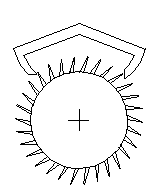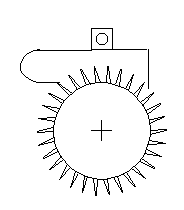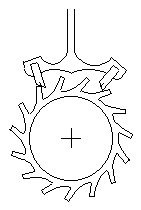Introduction:
Discover how much more there is to know about escapements by creating your own drawings. The purpose of this project is to introduce the reader, whether professional or hobbyist, to a hands-on method for drawing a mechanical clock or watch escapement. While it is more obvious that a manufacturer needs to know how to design a pallet, the repairman could do a better repair with an improved understanding of design theory. The ability to draw an escapement enables one to experiment more easily with the effects of changing the variables and to compare different types of escapements, their similarities and differences. Watch Escapements:
The most important reason for careful attention to design is efficiency. The escapements most frequently encountered at the bench are the Recoil, the Graham (or dead-beat), and the Swiss Lever. These all have efficiencies below 50%. This means that more than half the power is lost in the escapement alone, after all the power losses in the gear train.

Graham Escapement
Strip-Pallet Recoil
Modern Swiss Lever
Drawing watch escapements requires much more detail than drawing the
Graham (clock) escapement. I will pay most attention to the modern Swiss
watch with the club-tooth escape wheel as it is the most commonly
encountered at the bench. If you are a clockmaker or watchmaker who
understands everything summarized in this introduction, you probably do
not need this book. If you do not understand all of it, the cost of this book
would be the cheapest escapement course you ever took.
Watch and clock escapements are similar in that they should have
symmetrical designs, so that the impulses the pallets receive would be equal.
The efficiency of the escapement should be the same for both pallets. The
impulse face of each pallet should have an angle of 45º relative to the
direction of the force that the escape tooth applies to the pallet during
impulse if the angle between this force and the force that acts to rotate the
pallet were 90º. If the pallet's impulse face angle were not correct, there
would be a considerable loss of efficiency, or the ability of the balance
wheel to receive impulses from the escape wheel. This is covered in detail in
Chapter 4 of the Clock Escapement section.
The most significant difference between clock and watch escapements,
such as the Graham escapement and the Swiss Lever, is that the clock's
pendulum is not independent of the pallets, whereas the watch's balance
wheel is independent of the pallets most of the time. This means that the
clock escapement should have pallets with curved locking faces to achieve
a dead-beat, so that there would be no recoil as the escape tooth slides
along the pallet locking face. The watch escapement, however, should have
pallets with locking faces that allow the escape tooth to move forwards
slightly as it slides up the pallet's locking face, so as to create draw. The
draw is a small binding action that helps to keep the pallet fork over to the
side, against the banking pin, until the balance wheel's roller jewel returns, so
that the fork's guard pin would not rub against the balance wheel's roller
table and thereby interfere with the freedom of rotation of the balance wheel.
Since watches require draw, the equidistant lock of the pallets is desirable in
order to have equal draw for both pallets. This is covered in detail in
Chapter 9 of the Clock Escapement section.
If you are a watchmaker with no interest in clocks, I would
recommend that you consider reading the chapters concerning clock
escapements because the logic behind the drawings is the same, and it is
easier to introduce a reader to the drawing techniques with less difficult
examples, (in other words, examples of simpler escapements that apply to
clocks). It would be necessary to understand the basic principles behind
escapement drawings before attempting to draw complicated watch
escapements that would work in a simulation on a computer.
Go to Chapter 1
Escapements in Motion
Clock Repair Main Page
Links Page